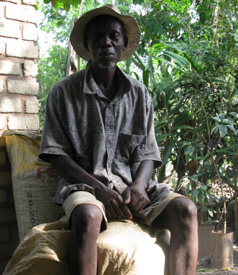Mutant pigweed, Amaranthus palmeri, caused by repeated application of Roundup to cotton. Pictures by Gretchen Quarterman, Coffee County, Georgia, 2 October 2010. More in the flickr set.
Tag Archives: Roundup
Monsanto rep meeting with president of Peru
García is the large man sitting in front of the flag. The Monsanto rep. is the short man sitting to García’s left.
It’s not clear when this meeting took place, but it may have been the one referred to in this 11 Oct 2007 story, which says: Continue reading
Managing the Seedbank by Plowing
About pigweed, Georgia Extension weed scientist Dr. Stanley Culpepper says:
Economic survival will depend on managing the seedbank!!!!That’s on page 30 of a 46 page presentation at the 2010 Beltwide – Consultants Conference, after discussing how rapidly Roundup-Ready seeds have been adopted:
And how the value of advice on weed control during that period rapidly decreased as a direct correlation: Continue reading
Pigweed: don’t let it come up
 So is it just a few people’s opinion that
plowing works much better than herbicides to control mutant pigweed?
So is it just a few people’s opinion that
plowing works much better than herbicides to control mutant pigweed?
Henry Gantz writes in Don’t Give Pigweed The Light Of Day, If it doesn’t come up, you don’t have to kill it that farmers were depending mostly on Roundup, but that no longer works, due to multiple mutant weeds, including pigweed and marestail. He quotes Dr. Larry Steckle, Extension weed specialist at the University of Tennessee:
Steckle said we’ve now reached the point where we have to begin thinking in terms of controlling “resistant weeds” instead of “resistant marestail” or “resistant Palmer pigweed” because they are both beginning to show up in the same field.So, what’s the solution: Continue reading“We have to manage them both,” he said. “There’s a new product from BASF called Sharpen that I’ve been looking at for five years and I’ve been very impressed with the marestail control. I still like dicamba, Roundup and Gramoxone.
“But if you have Palmer pigweed, too, then you’re going to have to overlap with residuals ― Cotoran, Caparol, Prowl ― to have any chance to do a good job of controlling them.”
Monsanto Fined $2.5 Million
 Jimmy Mengel
EPA Slaps Monsanto with Record Fine,
Million Dollar Settlement the Largest in Series of Penalties:
Jimmy Mengel
EPA Slaps Monsanto with Record Fine,
Million Dollar Settlement the Largest in Series of Penalties:
The agricultural giant was found to have been selling genetically modified cotton seeds without labeling them as such. Between 2002 and 2007, Monsanto’s seeds were illegally sold in several Texas counties where the seeds are explicitly banned.Here’s the bad news: Monsanto’s market cap is $29.5 billion, so the fine is less than a hundredth of a percent of that.The seeds — known as Bollgard and Bollgard II — were genetically engineered to produce the insecticide Bacillus thuringiensis (Bt), and Texas officials were concerned that using the seeds would lead to pest resistance.
But that didn’t stop Monsanto from bamboozling buyers into purchasing the illegal seeds.
Still, the fines keep going up. Maybe eventually they’ll get big enough to sting.
Or we could just trust the company that made Agent Orange and DDT.
Or we could remember this: Continue reading
Monsanto Price Drop
I think that’s CEO-speak for demand is down, competition is up, and Monsanto is retrenching in hopes of saving its core glysophate business. So sad.ST. LOUIS, May 27, 2010 /PRNewswire-FirstCall/ — Monsanto Company (NYSE:MON – News) today announced it is repositioning its Roundup® business in the face of fundamental structural changes that have caused upheaval in the glyphosate industry. Focusing its glyphosate products on supporting the core seeds-and-traits business, the company plans to drastically narrow its Roundup® brand portfolio to offer farmers a simple, quality product that meets their needs at a price closer to generics.
“By reducing the uncertainty associated with Roundup, we free Monsanto to grow on its fundamentals,” Chairman and Chief Executive Officer Hugh Grant said. “What matters to our long-term growth is our seeds-and-traits business, which is on track.”
More clarification from the CEO: Continue reading
Haitian: Monsanto seeds are a new earthquake
 Beverly Bell writes in truthout that
Haitian Farmers Commit to Burning Monsanto Hybrid Seeds:
Beverly Bell writes in truthout that
Haitian Farmers Commit to Burning Monsanto Hybrid Seeds:
In an open letter sent May 14, Chavannes Jean-Baptiste, the executive director of MPP and the spokesperson for the National Peasant Movement of the Congress of Papay (MPNKP), called the entry of Monsanto seeds into Haiti “a very strong attack on small agriculture, on farmers, on biodiversity, on Creole seeds … and on what is left our environment in Haiti.”Fortunately, the Haitian government agrees:
For now, without a law regulating the use of GMOs in Haiti, the Ministry of Agriculture rejected Monsanto’s offer of Roundup Ready GMOs seeds. In an email exchange, a Monsanto representative assured the Ministry of Agriculture that the seeds being donated are not GMOs.Well, who could doubt Monsanto? Apparently some influential Haitians. They even get that it’s not just about the chemicals:
Haitian social movements’ concern is not just about the dangers of the chemicals and the possibility of future GMOs imports. They claim that the future of Haiti depends on local production with local food for local consumption, in what is called food sovereignty. Monsanto’s arrival in Haiti, they say, is a further threat to this.Maybe people in other countries will also act to preserve what is left of our environment.
Cancer in the Air, Food, and Water
 Lyndsey Layton
writes in the Washington Post that:
Lyndsey Layton
writes in the Washington Post that:
An expert panel that advises the president on cancer said Thursday that Americans are facing “grievous harm” from chemicals in the air, food and water that have largely gone unregulated and ignored.Somebody noticed!
The President’s Cancer Panel called for a new national strategy that focuses on such threats in the environment and workplaces.The problem is not too many agencies. Here’s the problem: Continue readingEpidemiologists have long maintained that tobacco use, diet and other factors are responsible for most cancers, and that chemicals and pollutants cause only a small portion — perhaps 5 percent.
The presidential panel said that figure has been “grossly underestimated” but it did not provide a new estimate.
“With the growing body of evidence linking environmental exposures to cancer, the public is becoming increasingly aware of the unacceptable burden of cancer resulting from environmental and occupational exposures that could have been prevented through appropriate national action,” the panel wrote in a report released Thursday.
Federal chemical laws are weak, funding for research and enforcement is inadequate, and regulatory responsibilities are split among too many agencies, the panel found.
Hamster Roundup: sterility and infant mortality

|
“This study was just routine,” said Russian biologist Alexey V. Surov, in what could end up as the understatement of this century. Surov and his colleagues set out to discover if Monsanto’s genetically modified (GM) soy, grown on 91% of US soybean fields, leads to problems in growth or reproduction. What he discovered may uproot a multi-billion dollar industry.Not just a little higher: five times highher infant mortality.After feeding hamsters for two years over three generations, those on the GM diet, and especially the group on the maximum GM soy diet, showed devastating results. By the third generation, most GM soy-fed hamsters lost the ability to have babies. They also suffered slower growth, and a high mortality rate among the pups.
And it’s not necessarily the soybeans themselves: Continue reading
Liver and kidney damage: GM crops
A report published in the International Journal of Microbiology has verified once again that Monsanto’s genetically modified (GM) crops are causing severe health problems. A legal challenge issued against Monsanto forced the multi-national agriculture giant to release raw data revealing that animals fed its patented GM corn suffered liver and kidney damage within just three months.Adding to the mounting evidence that GM crops are dangerous all around, this information provides a damning indictment against Monsanto which continually insists that its GM products are safe. Not only are GM crops proving disastrous for the environment, but study after study, including those conducted by Monsanto itself, is showing that GM foods are detrimental to health.
This appears to be a publication in another venue of the same results we remarked on a couple of months ago. Still bad news for Monsanto.
But they’ve got nothing to hide, right?
Monsanto only released the raw data after a legal challenge from Greenpeace, the Swedish Board of Agriculture and French anti- GM campaigners.Oh. Nevermind.
Maybe Monsanto really is the least ethical company in the world.

